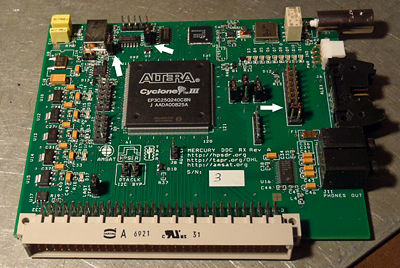Multi-Receiver
The openHPSDR receiver can be run in several configurations. Stand-alone, multiple receivers on a single MERCURY (one common antenna), and two or more MERCURY boards plugged into a single ATLAS (this allows two or more antennas). Each of these configurations require different hardware and software support but all have been successfully accomplished using MERCURY boards.
Contents
Stand-Alone
The options is supported by all software and all versions of the verilog code.
Current verilog code is Mercury 2.9 and Ozy 1.7
Multiple Receivers on a single Mercury
This options is supported by KISS Konsole on Windows and ghpsdr3 on Linux and (Windows under development).
This option is only supported by the Ozy 1.8 and Mercury 3.0 verilog code.
Multiple Mercury boards
(Last updated 7NOV2011)
This option is supported by PowerSDR v2.2.3.dual_Mercury using two Mercury boards and PowerSDR v.2.2.3.triple_Mercury using three Mercury boards.
Dual Mercury board setups (Windows): Diversity operation using two coherent Mercury receivers is implemented in PowerSDR v2.2.3.dual_Mercury (K5SO 26OCT2011). This program is a modification of Doug W5WC's PSDR v2.2.3 and permits the user to adjust the phase and gain of the non-reference IQ data stream relative to the reference IQ data stream to achieve diversity operation and selective nulling. Polarization diversity or spatial diversity are possible, depending upon what inputs are provided to the two Mercury boards. Mercury firmware v3.1 must be used with PowerSDR v2.2.3.dual_Mercury, the firmware and PC program are available for download at http://k5so.com. Required firmware: Metis v1.6, Mercury v3.1, and Penelope v1.6; Ozy v2.1 will be loaded automatically on startup of PSDR after a fresh power up of Atlas, if Ozy or Magister is present instead of Metis.
The second Mercury board can remain on the Atlas bus while running the other programs with no ill effects, the second Mercury board is simply ignored by single-Mercury programs.
Triple Mercury board setups (Windows): Operation using three coherent Mercury receivers is implemented in PowerSDR v2.2.3.triple_Mercury (K5SO 7NOV2011). This program is ALPHA code and is under active development and is frequently changed. The goal is to develop a beam steering program for three-antenna receiving arrays by means of appropriate phasing of the three independent, coherent, IQ data streams. Required firmware: Metis v1.6, Mercury v3.1, and Penelope v1.6; Ozy v2.1 will be loaded automatically on startup of PSDR after a fresh power up of Atlas, if Ozy or Magister is present instead of Metis. PowerSDR v2.2.3.triple_Mercury will run with 1, 2, or 3 Mercury boards. The firmware and the PC program are available for download at http://k5so.com.
Required Hardware Configurations To Use Multiple Mercury Boards
(last updated 31OCT2011)
Each Mercury board must have jumpers in place to specify a unique address for the board and a jumper in place to specify that the board is being used simultaneously with other Mercury boards. Each board will have a different jumper-selected address. The address is specified by placing jumpers on J5 (GPIO pins) on the Mercury board. Looking at the Mercury board with the Atlas bus connector down, the GPIO pins on J5 are arranged such that the lowest pair of pins (closest to F1) are GPIO pins 1,0. Without a jumper, the logic value for the GPIO pin pair is "0", with a jumper across the pins the logic value is "1". The Mercury board address is specified as a 3-bit address according to the jumpers placed on J5. The GPIO pins on J5 are assigned as follows:
GPIO pairs:
9,8 = Mercury ID bit 2,
7,6 = Mercury ID bit 1,
5,4 = Mercury ID bit 0,
3,2 = MULTIPLE_MERC
1) All Mercury boards used in multiple-Mercury-board operations must have the MULTIPLE_MERC jumper (GPIO 3,2) in place.
2) The address of the first Mercury board should be "000", selected by having no jumpers on GPIO pins 9-8, 7-6, or 5-4. The address of the second Mercury board should be "001", selected by having a jumper on GPIO pins 5-4; and so on for any additional Mercury boards present. Photos of Mercury boards addressed for logical 0 (Merc1) and logical 1 (Merc2) are shown on the K5SO download site referenced above.
Therefore, for dual Mercury boards, the 3,2 GPIO jumper pair should be on both Mercury cards, the first Mercury board is set for Merc_ID = 000 (no jumpers on pins 9-8, 7-6, or 5-4) and the 2nd Mercury card is set for Merc_ID = 001 (a jumper across the 5,4 pair).
3) Configuring the 122.88MHz clocks on the Mercury boards:
3a) place a jumper on the CLKSEL "I" pins (lower two pins of the three CLKSEL pins) on one of the Mercury boards (this will be the "master" Mercury board), no such jumper is placed on the equivalent pins of the slave Mercury board(s),
3b) place a jumper on JP9 (enabling the 122.88MHz oscillator) on the master Mercury board but not on the (other) "slave" Mercury board(s)
3c) place a jumper from the Atlas C16 pin to J8 (Aux Clk input) pin nearest the FPGA on all Mercury boards
3d) connect a twisted-wire pair to pins 1 & 2 of J1 (LVDS header) of the "master" Mercury board and the other end to pins 4 & 5 of J1 (LVDS header) on the "slave" Mercury board(s), see photos at http://www.k5so.com/Clock%20connections.html.
3e) in PowerSDR, select Setup>Excalibur for the 10 MHz clock source and Mercury as the 122.88 MHz clock source.
Now all Mercury boards will be operating from the single 122.88 MHz oscillator on the master Mercury board. The coaxial connection between the Mercury boards is required to achieve long-term coherent operation of the Mercury boards.
4) 10 MHz clock on Mercury: The 10MHz clock for the Mercury boards should be taken from Excalibur (or whatever external 10MHz source you use) via the Atlas C16 pin, with Mercury jumpered as noted above.
See also
- Multiple independent receivers - how to set up on Windows - not the same as above, but related.
